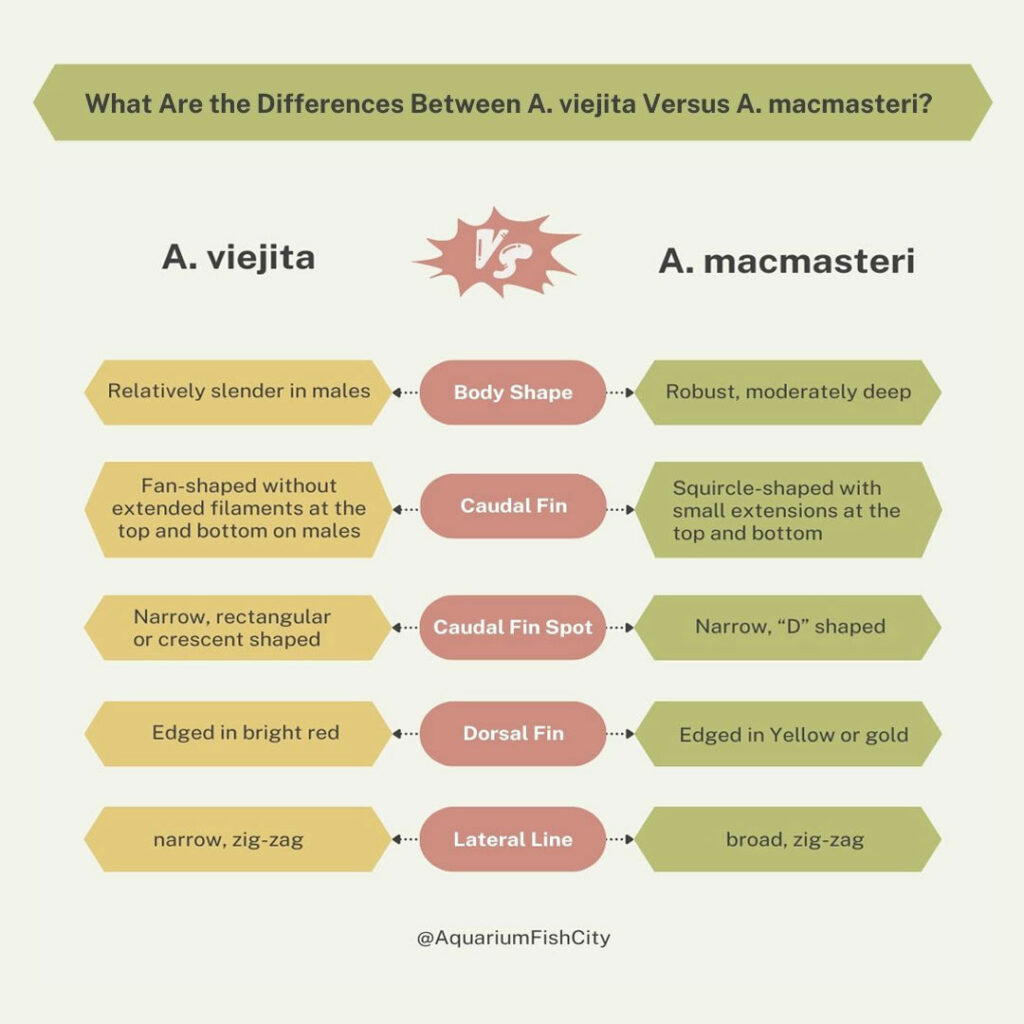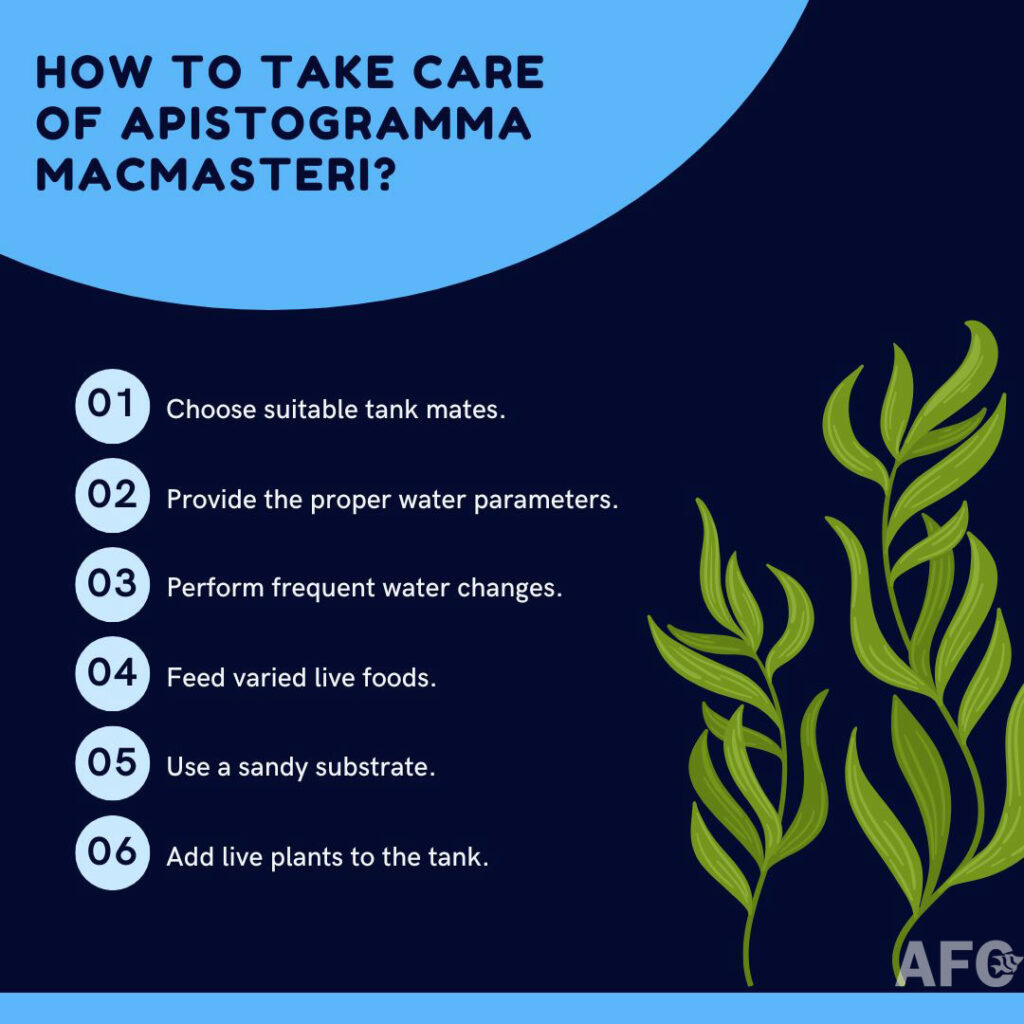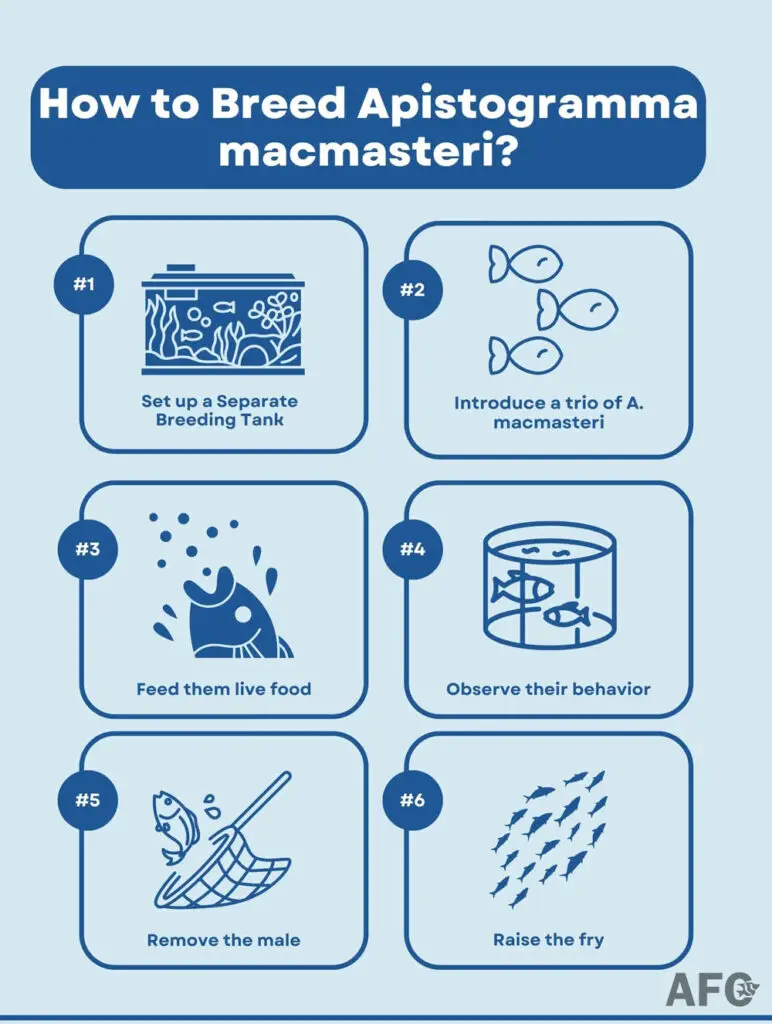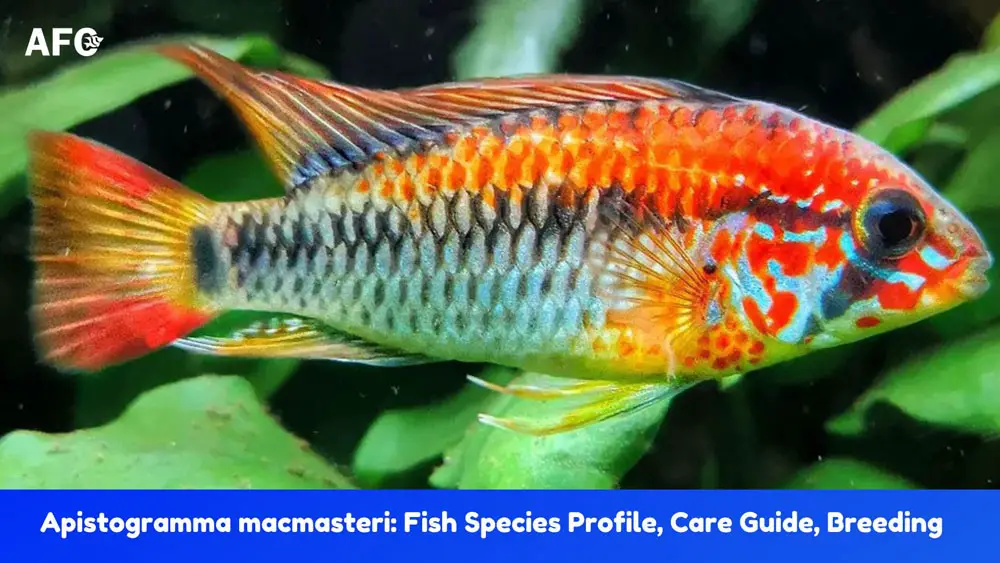Apistogramma macmasteri is a colorful and hardy dwarf cichlid that is undemanding in terms of water hardness. This makes it a popular choice among many beginner aquarists.
There are many color varieties of this apisto sold in the pet fish market, developed by selective breeding based on their two naturally occurring colors: red and yellow. The color-enhanced red varieties are often mistaken for tank-raised A. viejita, given their vivid red bodies.
While the gender differences can be fairly notable in adult fish, there really isn’t much difference between the juveniles.
Male Apistogramma macmasteri are some of the larger-sized apistos, and they tend to exhibit extreme aggression and territorial behavior during the breeding season.
A. macmasteri is also relatively easy to breed in captivity because it does not require specific soft and acidic water like most others.
In this article, we will take an in-depth look at the fish species profile, care guide, and breeding requirements of the A. macmasteri, a long-time favorite cichlid in freshwater aquariums.
What Are the Types of Apistogramma macmasteri?
The naturally occurring colors of Apistogramma macmasteri are yellow and red. The yellow form is listed as A 120 and the latter as A 121 among dwarf cichlid hobbyists.
These two wild forms of A. macmasteri do not exhibit the intense colors seen in their captive-bred counterparts, which are the result of extensive selective breeding practices.
Due to their popularity, Apistogramma macmasteri have been readily bred in captivity, and the majority of fish commonly available to hobbyists are those red-shoulder variations.
Here are several popular trading names for the red-shoulder variations.
- Apistogramma macmasteri ‘Super Red’
- Apistogramma macmasteri ‘Red Mask’
- Apistogramma macmasteri ‘Red Neck’
- Apistogramma macmasteri ‘Red Shoulder’
It is believed that these color-enhanced strains were developed by crossing the wild Red Shoulder form (A 121) with the A. viejita or more than one undescribed species in the A. macmasteri species group to enhance the vivid red body color, making it difficult to distinguish them from the domestically bred strains of A. viejita.
Additionally, man-made variations of the wild Yellow color morph (A 120) also exist. They are created to produce shiny gold coloring and are sold as follows.
- Apistogramma macmasteri ‘Gold’
- Apistogramma macmasteri ‘Gold Red Shoulder’
- Apistogramma macmasteri ‘Red Neck Gold’
- Apistogramma macmasteri ‘Gold Red Mask’
- Apistogramma macmasteri ‘Platinum Red Shoulder’
What Are the Differences Between A. macmasteri Versus A. viejita?
The main difference between A. macmasteri and A. viejita is that the male A. viejita has a dark top edge on its dorsal fin, whereas it is absent in the male A. macmasteri. That’s why many sellers use the common name Red Edge Apisto and Red Neck Apisto to refer to them, respectively.
A. macmasteri, on the other hand, develops extended tips on the caudal fin, and the spines on a dorsal fin are tipped with either silver, golden, or red.
Additionally, the body of A. macmasteri is robust and moderately deep, and a “D” shaped spot adorns the caudal fin, whilst A. viejita sometimes shows a distinct spot in rectangular, trapezoid, or crescent.
In fact, the true wild-caught A. viejita is a very rare Apistogramma fish that is not captive-bred for commercial sale, but it is relished by professional breeders.

How to Tell a Male From a Female Apistogramma macmasteri?
A. macmasteri males typically have a longer dorsal fin with serrated hard spines and pointed tips on both lobes of the round caudal fin. They are generally larger than females when viewed from the side. It’s hard to tell the sexual differences when they are juveniles that are smaller than 1.5 inches (4 cm).
How Big Do Apistogramma macmasteri Get?
Apistogramma macmasteri grows to a maximum standard length (SL) of about 2.2 inches (5.5 cm), which measures everything except the caudal fin, according to the Check List of the Freshwater Fishes of South and Central America by Sven O. Kullander.
Because of their extended dorsal and anal fins, adult males can reach a total length (TL) of 2.8 inches (7 cm) or more, depending on how well they are cared for and fed.
Are Apistogramma macmasteri Aggressive?
Yes, A. macmasteri are more aggressive than other Apistogramma species. This is because male A. macmasteri have evolved a highly polygynous mating system in which a male mates with several female partners during the breeding season. As such, they defend more breeding territories and display defensive or aggressive behaviors with potential partners.
In the wild, a dominant male congregates with a harem of females. However, maintaining them in harems is usually impractical in medium-sized tanks due to the limited space. Too many females in an aquarium setting can also lead to conflict between females, which can sometimes be quite severe.
As with the other polygynous members of this family, Apistogramma macmasteri should be kept in a trio of one male and two females. This will help to reduce aggression and promote breeding.
What Is The Minimum Tank Size For Apistogramma macmasteri?
A 20-gallon Long (30″ x 12″ x 12″) is the minimum tank size to house a trio of Apistogramma macmasteri.
It’s important to offer each female a breeding territory of at least 12 inches (30 cm) in diameter if you plan to set up a breeding group. A wider tank with a larger footprint is always better than a narrow one.
How Long Does Apistogramma macmasteri Live?
Apistogramma macmasteri has an average lifespan of two years, according to a statistical study of 7,532 specimens in 23 different Apistogramma species by Dr. Uwe Römer in 1991.
Nevertheless, with exceptional care, they can survive up to five years. The lifespan of Apistogramma is not something you can control, so do your best by offering them the best tank conditions and a well-balanced diet to reach the upper end of that range.
Where do Apistogramma macmasteri Come From?
Apistogramma macmasteri is an endemic species found only in the upper Río Meta System in Colombia, where it inhabits the slow-flowing clear water and blackwater streams and tributaries along the foothills of the Andean Cordillera, stretching from Villavicencio to Tame (Koslowski, 2002).
In their natural habitat, they are found among fallen leaves, driftwood piles, and marginal vegetation. The water is typically soft and acidic due to tannic, humic, and fulvic acids released from decaying organics.
How to Take Care of Apistogramma macmasteri?
Here are the basics of Apistogramma macmasteri care.
- Choose suitable tank mates.
- Provide the proper water parameters.
- Perform frequent water changes.
- Feed varied live foods.
- Use a sandy substrate.
- Add live plants to the tank.
What Fish Can Live With Apistogramma macmasteri?
These are some of the suitable tank mates for Apistogramma macmasteri.
- Freshwater Angelfish: An medium-sized South American cichlid that will stay in the middle of the fish tank and leave the bottom-dwelling A. macmasteri to their own business. This combination is more suitable for tanks that are larger than 55 gallons.
- Neon tetras: This 1.5 inches (4 cm) South American tetra is extremely popular because of its glowing red and blue stripes. They live in shoals in the middle water layers and require similar water conditions (pH, temp, and hardness) as the A. macmasteri.
- Cardinal tetras: An alternative to neon tetra but slightly larger (up to 2 inches or 5 cm) and pricey. These fish are generally collected from the wild and sometimes are more sensitive to water quality parameters.
- Freshwater Hatchetfish: A group of small, peaceful, and unique surface-dwellers that are native to South America. A shoal of 10 or more hatchetfish will definitely add a unique touch of beauty and life to any Apistogramma macmasteri community tank.
- Pencilfish: Another outgoing dither fish that mostly swim in the upper third of the water volume. A group of pencilfish is the perfect companion in breeding tanks because they are safe for A. macmasteri fry to come out and explore.
- Corydoras and Otocinclus catfish: Both species are bottom-dwellers and adorable algae-eaters for the A. macmasteri community aquarium. However, like tetras, they get a bad reputation for being skilled egg/fry predators.
Can You Mix Apistogramma macmasteri with Other Apistogramma Species?
Yes, you can mix Apistogramma macmasteri with other Apistogramma types, as long as they belong to different species groups, the tank is properly decorated, and they are similar in size and temperament.
For example, Apistogramma cacatuoides and Apistogramma borellii usually don’t go well together because of the large size and aggressive nature of A. cacatuoides.
However, most Apistogramma owners will advise against keeping different Apistogramma species in the same tank. Although Apistogramma species are less likely to cross breed, it’s hard to separate the fry once they are released. As such, it’s recommended to keep them in their own tanks with other tank mates.
What Are The Ideal Water Parameters for Apistogramma macmasteri?
The ideal water parameters for Apistogramma macmasteri are the following values.
- Temperature: 76° to 80° F (24° to 27° C)
- pH: 5.5 to 6.0
- GH: <1º dGH
- KH: <2º dKH
- Conductivity: <10 µS/cm
These ideal water parameters refer to the ranges of the water chemistry of the location or type locality where A. macmasteri was first identified.
The good thing is that tank-raised individuals have the advantage of being hardy and adaptable to most untreated water values, making maintaining them less of a hassle.
To ensure the well-being of specimens that are sourced from the wild, it is best to replicate the water conditions of their natural environment as closely as possible.
Do not expose these fish to strong currents. Small sponge filters are a simple and cost-effective way to create the kind of water movement they need.
Can Apistogramma macmasteri Live in Hard Water?
Yes, Apistogramma macmasteri can live and reproduce in moderately hard water with a GH level of 8 to 12 dGH (140 to 210 ppm).
However, it is not advisable to keep this species in hard water for long periods as the fish’s lifespan may be reduced due to chronic stress.
How Often Should You Do Water Changes for Apistogramma macmasteri?
You should perform a small 10-15% water change every week for A. macmasteri, as this species is sensitive to any sudden, massive water changes that often cause external bacterial infections.
As with other Apistogramma types, get yourself a reliable test kit to help you make sure the water parameters are in the ideal range.
What Do Apistogramma macmasteri Eat?
The best foods for Apistogramma macmasteri include live daphnia, mosquito larvae, glassworms, bloodworms, and newly hatched brine shrimp. Tubifex and blackworms should be avoided for all Apistos because they lack cleanliness.
Frozen foods are a good alternative if you don’t have access to live foods or if they are too costly.
Tank-raised strains are trained to accept sinking flake foods. However, many dwarf cichlid breeders often feed their fish live foods because they are more nutritious and beneficial for the fish’s coloration. As a result, these fish are picky eaters and may refuse to eat dry foods.
How Often Should You Feed Apistogramma macmasteri?
You should feed A. macmasteri 2 – 3 times daily with small portions, and be sure not to overfeed them.
What is the Best Aquarium Substrate for Apistogramma macmasteri?
The best substrate for Apistogramma macmasteri is fine-grained sand (0.5-1.7 mm grain size) that serves several purposes, as follows.
- Creating a more natural habitat for the Apistogramma macmasteri that like to sift through the substrate to look for food.
- Enhancing the aquarium’s aesthetics with sandy tones and textures.
- Making the maintenance of water parameters easier because it’s inert and doesn’t affect the water’s chemistry.
Do Apistogramma macmasteri Need Plants?
Yes, Apistogramma macmasteri need plants to feel secure and relaxed in their environment, particularly when kept in a community tank.
When choosing plants for Apistogramma macmasteri, it’s nice to add some floating plants, such as Amazon frogbit, hornwort, water lettuce, and Anacharis. These floating plants not only create an environment that is visually appealing and natural but also subdue the lighting, which is appreciated by any Apistogramma.

How to Breed Apistogramma macmasteri?
Breeding A. macmasteri involves the following steps.
Step 1: Set up a separate breeding tank
Set up a 20-gallon breeding tank with a sandy substrate, subdued lighting, and several spawning caves. Add 2-5 dwarf pencilfish (N. marginatus) to the tank to let A. macmasteri feel safe and comfortable.
In terms of water parameters, wild forms have been successfully bred in an aquarium with a pH of 5.5 – 6.5, GH of 4 – 5° (70 – 90 ppm), low TDS (<100 ppm), and a temperature range of 76–81° F (24–27 °C).
Tank-raised specimens have been bred in tanks with similar water parameters but usually take hard water better than their wild counterparts.
Step 2: Introduce a trio of A. macmasteri
Introduce a trio of one male and two females in the breeding tank. The best way to acquire them is from a reliable source that has properly conditioned specimens so they can spawn more easily.
If you intend to breed wild-caught A. macmasteri, it is highly recommended to a half-dozen or more juveniles and raise them together in a species-only aquarium. This approach not only allows you to observe the diverse social behavior of dwarf cichlids but also increases the likelihood of obtaining the natural group spawners.
Step 3: Feed them live food
Condition the fish with a variety of live food, as explained in the previous section.
Step 4: Observe their behavior
The male will become more colorful and aggressive. Watch the male’s behavior and see if he shows any signs of aggression towards the female who is not ready to spawn.
Being a secretive cave spawner, the mating ritual and spawning process of A. macmasteri occur mostly in seclusion until the fry are found in the tank. Courtship in Apistogramma is typically initiated by the female, who can produce around 100 eggs attached to the ceiling of caves.
The female often blocks off the entrance to the spawning site with sand once the eggs are laid.
Step 5: Remove the male
Once you have observed signs of a successful spawn, it is best to remove the male from the tank, as he will try to spawn again. The brooding female can be quite aggressive and will chase or attack the male.
Step 6: Rear the fry
In three days, the eggs will hatch, and the fry become free-swimming in 4-7 days. Newly hatched brine shrimp can be used as their first food.

Where to Buy Apistogramma macmasteri
A. macmasteri is a staple of Apistogramma in the fish trade, and domestic tank-raised specimens are widely available in local and online fish stores.
Wild-caught A. macmasteri can be found in AquaImports and individual breeders on Aquabid and The Band app.
